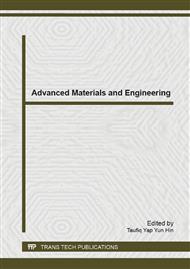p.161
p.166
p.171
p.175
p.179
p.185
p.190
p.194
p.198
Improving Mechanical Properties of Poly-β-Hydroxybutyrate-co-β-Hydroxyvalerate by Blending with Natural Rubber and Epoxidized Natural Rubber
Abstract:
Poly-β-hydroxybutyrate-co-β-hydroxyvalerate (PHBV) is a bacterial-synthesized biopolymer. Moreover, PHBV is a biodegradable, it is an interesting biopolymer for disposable products. PHBV is difficult to process due to its low toughness, an elastic polymer such as natural rubber is introduced to develop toughness. In this experiment, PHBV mechanical properties were improved by blending with natural rubber (NR) and epoxidized natural rubber (ENR). The NR/PHBV and ENR/PHBV blends with the same ratio of 10/90 (wt/wt) could be extruded, whereas other conditions could not. This ratio was then used throughout this study to examine effect of maleic anhydride (MA) and benzoyl peroxide (BPO) to improve toughness of the blends. Result showed at composition where 1.0 % (wt/wt) MA and 0.05 % (wt/wt) BPO was mixed (coding EPMB2), several aspects of mechanical properties were improved. The blend, EPMB2 revealed the highest impact strength, significantly improved of elongation but drastically decreased of tensile strength. Storage modulus slightly decreased, tangent delta significantly increased when compared with neat PHBV.
Info:
Periodical:
Pages:
179-182
Citation:
Online since:
June 2014
Price:
Сopyright:
© 2014 Trans Tech Publications Ltd. All Rights Reserved
Share:
Citation:


